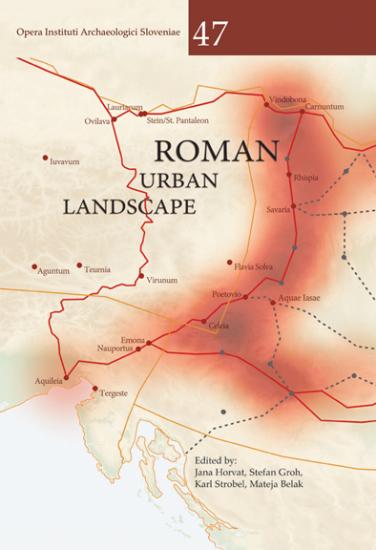
Edited by:
Jana Horvat, Stefan Groh, Karl Strobel, Mateja Belak
Year:
2024
A book presents new elements of the urbanistic aspects of Roman towns and minor settlements in the large area of Caput Adriae, Noricum, and Pannoniae. The result of these efforts is twenty-six contributions by 54 authors from eight countries (Austria, Slovenia, Italy, Croatia, Hungary, Serbia, Montenegro, North Macedonia). With this publication, we have attempted to expand the knowledge about the development of towns and some other important settlements and their integration into a larger network of urban and rural agglomerations.
The initial two articles present broader but different perspectives on urbanisation. In the next part, twenty-two settlements are discussed. The extreme north-east of Regio X is represented by four settlements (Aquileia, Tergeste, Emona and Nauportus). The book includes most of the autonomous towns in Noricum as well as some other settlement areas (Celeia, Flavia Solva, Virunum, Magdalensberg, Teurnia, Aguntum, Iuvavum, Ovilava, Lauriacum, Stein). Selected towns and minor settlements are presented from the provinces of Pannonia Superior (Vindobona, Carnuntum, Strebersdorf, Savaria, Poetovio, Aquae Iasae) and Pannonia Inferior (Mursa, Bassiane).
The book offers the most important results of mainly large research groups. Two research strategies stand out in particular, with which it was possible to record comprehensive data on large or even massive ancient settlements. Systematic and large-scale geophysical surveys have provided excellent insight into areas that were not built on in modern times. These surveys are combined with various other methods such as aerial photography, LiDAR images, surface surveys and archaeological excavations (e.g., Carnuntum, Flavia Solva, Stein, Teurnia). In modern, heavily built-up areas, however, researchers relied mainly on the accurate recording and mapping of all kinds of archaeological evidence, from chance finds to preventive excavations. After several decades, this tedious and laborious work led to rich results (e.g., Ovilava, Iuvavum, Celeia, Mursa, Emona, Aquileia). In most cases, however, combining all possible traditional and modern methods enabled an enormous increase in knowledge.
The area is located in the contact zone between the eastern and western halves of the Empire and encompasses parts of the three geographical areas (i.e., the Mediterranean, Alpine and Continental worlds), which could make the book interesting for a broader understanding of the functioning of the Roman Empire.
-
Edited by
Other authors
individual contributions
Kristina Adler-Wölfl, Martin Auer, Patrizia Basso
, Iris Bekljanov Zidanšek
, Szilvia Bíró
, Jacopo Bonetto
, Massimo Braini, Daniela Cottica
, Valentina Degrassi, Simone Dilaria
, Heimo Dolenz, Damjan Donev
, Matej Draksler, Desiree Ebner-Baur, Josef Eitler
, Snežana Ferjančić
, Federica Fontana
, Andrej Gaspari
, Andrea Raffaele Ghiotto
, Gerald Grabherr
, Stefan Groh
, Christian Gugl
, Peter Höglinger, Jana Horvat
, Lisa Huber, Barbara Kainrath
, Andreas Kall, Stefan Kasic, Julia Klammer
, Jure Krajšek, Dora Kušan Špalj, Julia Leitold, Tino Leleković, René Masaryk, Renate Miglbauer
, Danica Mitrova
, Martin Mosser
, Olga Pelcer Vujačić
, Ana Plestenjak, Eduard Pollhammer, Marina Rubinich
, Eleni Schindler Kaudelka, Helga Sedlmayer, Yvonne Seidel
, Ottó Sosztarits, Karl Strobel, Eva Thysell, Cristiano Tiussi, Stefan Traxler, Paola Ventura, Petra Vojaković
, Mario Wallner
, Tina Žerjal
-
Publishing House:
Založba ZRC
-
Publisher
-
ISBN
978-961-05-0827-4
-
Year
2024
-
Series
Language(s)
-
Specifications
hardback 20 × 29 cm 516 pages 303 maps, plans and photographs
-
E-publications
01. 03. 2024
-
Permalink